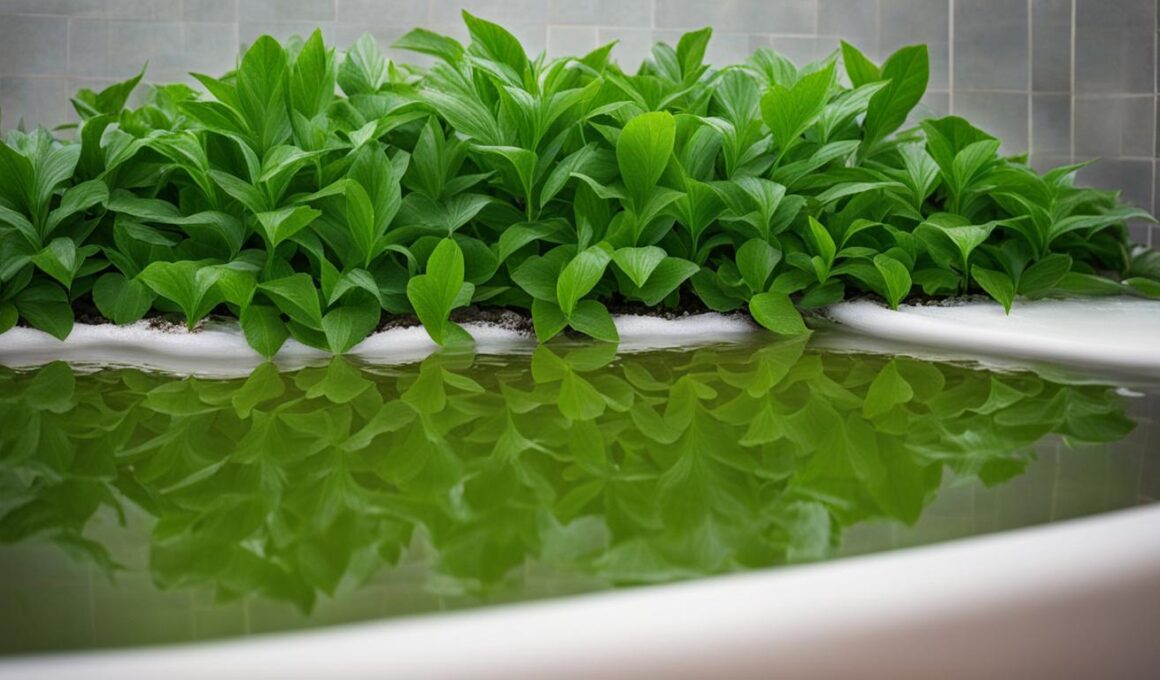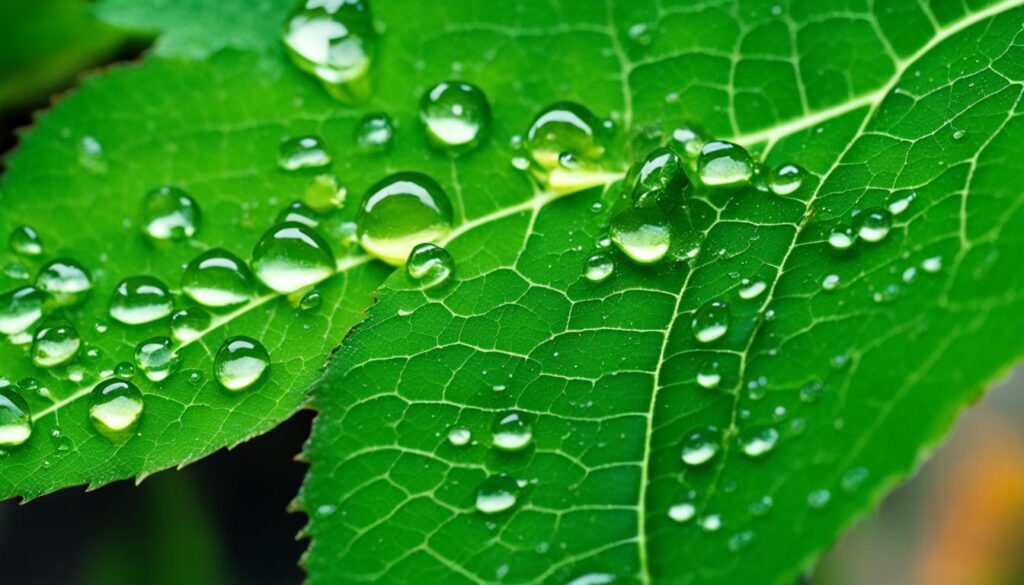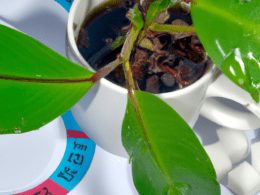Using hydrogen peroxide on plants can be a beneficial strategy for gardeners looking to optimize their green thumb skills. However, it is crucial to understand the potential effects and the harm that can occur when using too much hydrogen peroxide. To ensure the health and well-being of your plants, it is essential to follow recommended guidelines and use this gardening aid judiciously.
Key Takeaways:
- Using hydrogen peroxide on plants can have negative effects if not used properly.
- Proper dilution and concentration are crucial when using hydrogen peroxide in gardening.
- Hydrogen peroxide can be a versatile tool for pest control, treating root rot, and preventing fungal infections.
- Applying hydrogen peroxide sparingly and following safety precautions is essential.
- Optimizing your green thumb strategy involves understanding the effects of hydrogen peroxide and using it in moderation.
Understanding the Effects of Hydrogen Peroxide on Plants
Hydrogen peroxide has both positive and negative effects on plants, depending on its concentration and usage. When used in a properly diluted solution, hydrogen peroxide can promote healthy root growth and improve nutrient absorption. It is recognized by the United States EPA and is composed of the same atoms as water, with an additional oxygen atom. This extra oxygen can be beneficial for plants.
However, it is important to note that using too much hydrogen peroxide can harm or even kill plants. The concentration of hydrogen peroxide used is crucial, and it is essential to follow recommended guidelines to avoid damage. Dilution is key, and using a higher concentration than necessary can lead to adverse effects on plant health.
To ensure the safe and effective use of hydrogen peroxide on plants, always follow the recommended dilution ratios. Start with a low concentration and gradually increase if necessary. Testing the solution on a small area of the plant before applying it to the whole plant can help assess its tolerance. Remember, using hydrogen peroxide in the right concentration can be beneficial for your plants, while using it improperly can cause harm.
Proper Usage of Hydrogen Peroxide in the Garden
Hydrogen peroxide can be a versatile and effective tool for various gardening purposes. By understanding the proper usage and dilution guidelines, you can harness its potential benefits while minimizing any potential harm to your plants.
Using Hydrogen Peroxide for Pest Control
One of the ways hydrogen peroxide can be used in the garden is for pest control. It can help eliminate unwanted insects and pests without the use of harsh chemicals. To create a pest control solution, dilute hydrogen peroxide with water in the recommended ratios. Apply the solution directly to affected areas or use it as a foliar spray. Remember to focus on the undersides of leaves, where pests often hide. Regular application can help keep your plants free from infestations and maintain their health.
Treating Root Rot and Pre-Treating Seeds
Hydrogen peroxide can also be beneficial in treating root rot, a common problem for plants. To address this issue, mix a diluted solution of hydrogen peroxide and water and apply it to the affected plants’ roots. The oxygen component of hydrogen peroxide can help combat the root rot, promoting healthier root growth. Additionally, pre-soaking seeds in a hydrogen peroxide solution can help prevent fungal infections and improve germination rates. The solution can also help remove any potentially harmful microorganisms present on the surface of the seeds.
Using Hydrogen Peroxide as a Foliar Spray
A foliar spray with a hydrogen peroxide solution can be beneficial for combating fungus and promoting overall plant health. Dilute hydrogen peroxide with water according to the recommended ratios and apply it directly to the foliage. This can help prevent and treat fungal infections, as well as enhance the plant’s ability to absorb nutrients. Be sure to apply the spray evenly and avoid spraying during the hottest hours of the day to prevent any potential leaf damage.
Remember, hydrogen peroxide should be used sparingly and in the proper concentrations. While it can offer several benefits to your plants, excessive use or high concentrations can harm your plants. Always follow recommended guidelines and monitor the response of your plants to ensure you are using hydrogen peroxide effectively and safely in your garden.
How Often to Apply Hydrogen Peroxide to Plants
When it comes to applying hydrogen peroxide to plants, the frequency depends on the specific purpose you have in mind. If you are treating a fungal infection or an ill plant, hydrogen peroxide can be used until the problem clears up or the plant shows signs of improvement. The antifungal properties of hydrogen peroxide can help combat the infection and promote healing.
However, it’s important to note that hydrogen peroxide does not need to be used for every watering or on a regular basis. For general gardening purposes, it is not necessary to use hydrogen peroxide frequently. Many gardeners have found success using it sparingly, such as for watering young plants or pre-treating seeds, to give them a growth boost.
While hydrogen peroxide can have positive effects on plant growth, it’s crucial to use it judiciously and respect the concentration guidelines. Applying hydrogen peroxide too often or in higher concentrations than recommended can potentially harm your plants. It’s always best to follow the specific instructions provided for the particular use you have in mind and monitor your plants closely to ensure they are responding positively.
Safety Precautions and Variations in Recommendations
When it comes to using hydrogen peroxide in your gardening endeavors, it is important to prioritize safety. While hydrogen peroxide is generally safe when properly diluted, it is crucial to follow the necessary precautions. Higher concentrations of hydrogen peroxide can be harmful to the skin, causing bleaching or burning. To avoid any mishaps, always handle hydrogen peroxide with care and use protective gloves when necessary.
Dilution recommendations are key when using hydrogen peroxide in your garden. Different sources may provide varying recommendations, and it is important to find what works best for your specific needs. Remember that there is no one-size-fits-all approach. Take into account the concentration guidelines provided by trusted sources and consider the experiences of fellow gardeners who have explored different approaches. By finding a balance that works for you, you can ensure the safe and effective use of hydrogen peroxide in your gardening routine.
“When using hydrogen peroxide, always follow dilution guidelines and exercise caution to prevent any harm to yourself or your plants.”
It’s worth noting that the dilution recommendations may vary depending on the intended use of hydrogen peroxide. For example, when using hydrogen peroxide as a general gardening aid, proper dilution is crucial. The recommended amounts to add to water will vary based on the volume of water. Similarly, when using hydrogen peroxide as a foliar spray for sick or fungus-infested plants, the recommended amounts will also depend on the volume of water. It is essential to research and follow the dilution guidelines specific to your gardening needs to ensure the best possible results.
Variations in Concentration Guidelines
When it comes to dilution recommendations for hydrogen peroxide in gardening, it is important to acknowledge that there are variations among sources. Different gardeners may have different approaches that have worked well for them. While these variations exist, it is essential to prioritize safety and not exceed the recommended concentrations. Remember that hydrogen peroxide can be a valuable tool in your gardening arsenal when used correctly and responsibly.
Conclusion
In conclusion, hydrogen peroxide can be a valuable tool in gardening for optimizing your green thumb strategy and preventing harm to your plants. By understanding the effects of hydrogen peroxide on plants and implementing proper usage, you can effectively promote healthy plant growth while controlling pests, treating root rot, and preventing fungal infections.
It is essential to follow recommended guidelines when using hydrogen peroxide in gardening. Use it sparingly and only as needed, ensuring the proper concentration is applied. Remember that hydrogen peroxide is not a fertilizer, but it can enhance your plants’ nutrient absorption.
Take safety precautions when handling hydrogen peroxide, as higher concentrations can be harmful to the skin. Carefully measure and mix the appropriate amount following the recommended dilution guidelines. Keep in mind that there may be variations in the dilution recommendations, as different sources provide different approaches based on individual experiences.
By incorporating hydrogen peroxide into your gardening routine responsibly, you can optimize your plants’ health and growth, ensuring a successful and thriving garden.
Is Soaking Plant Roots in Hydrogen Peroxide Harmful?
Soaking roots in hydrogen peroxide can be beneficial for plants as it can help prevent root rot and fungal infections. However, it’s important to dilute the hydrogen peroxide properly to avoid harming the roots. A weak solution of hydrogen peroxide can promote healthy root growth without causing any harm.
FAQ
Is hydrogen peroxide safe for plants?
Hydrogen peroxide is generally safe for plants when used in a properly diluted solution.
What are the potential effects of using too much hydrogen peroxide on plants?
Using too much hydrogen peroxide can harm or even kill plants.
How can hydrogen peroxide be used in the garden?
Hydrogen peroxide can be used for pest control, treating root rot, pre-treating seeds, as a foliar spray to kill fungus, and as an infection preventive for damaged trees.
How should hydrogen peroxide be diluted for use in the garden?
The recommended amounts of hydrogen peroxide to add to water vary based on the volume of water and the specific purpose, such as watering or misting plants, soaking seeds, washing sprouts, or using as a foliar spray.
How often should hydrogen peroxide be applied to plants?
The frequency of hydrogen peroxide application depends on the specific purpose. It can be used until the problem clears up or improvement is observed for treating fungal infections or sick plants. However, for general gardening purposes, it is not necessary to use hydrogen peroxide frequently.
What safety precautions should be taken when using hydrogen peroxide?
While hydrogen peroxide is generally safe when properly diluted, higher concentrations can be harmful to the skin. It is important to carefully measure and mix the appropriate amount of hydrogen peroxide based on the recommended guidelines.
Are there variations in the dilution recommendations for hydrogen peroxide in gardening?
Yes, there are variations in the dilution recommendations for hydrogen peroxide in gardening. Different sources may provide different recommendations based on the experiences of gardeners who have tried different approaches.











